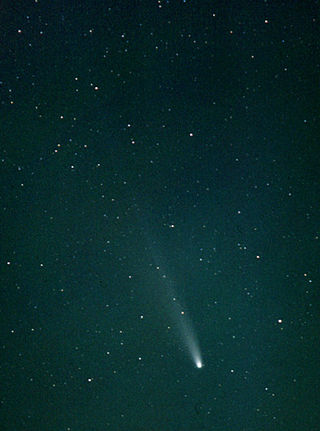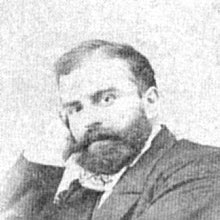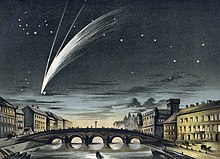
The Great Comet of 1811, formally designated C/1811 F1, is a comet that was visible to the naked eye for around 260 days, the longest recorded period of visibility until the appearance of Comet Hale–Bopp in 1997. In October 1811, at its brightest, and when it was 1.2 AU from Earth, it displayed an apparent magnitude of 0, with an easily visible coma.

Comet Encke, or Encke's Comet, is a periodic comet that completes an orbit of the Sun once every 3.3 years. Encke was first recorded by Pierre Méchain on 17 January 1786, but it was not recognized as a periodic comet until 1819 when its orbit was computed by Johann Franz Encke. Like Halley's Comet, it is unusual in its being named after the calculator of its orbit rather than its discoverer. Like most comets, it has a very low albedo, reflecting only 4.6% of the light its nucleus receives, although comets generate a large coma and tail that can make them much more visible during their perihelion. The diameter of the nucleus of Encke's Comet is 4.8 km.

The Great Comet of 1843, formally designated C/1843 D1 and 1843 I, was a long-period comet which became very bright in March 1843. It was discovered on February 5, 1843, and rapidly brightened to become a great comet. It was a member of the Kreutz Sungrazers, a family of comets resulting from the breakup of a parent comet into multiple fragments in about 1106. These comets pass extremely close to the surface of the Sun—within a few solar radii—and often become very bright as a result.

The Great Comet of 1861, formally designated C/1861 J1 and 1861 II, is a long-period comet that was visible to the naked eye for approximately 3 months. It was categorized as a great comet—one of the eight greatest comets of the 19th century.

Comet Ikeya–Zhang is a comet discovered independently by two astronomers from Japan and China in 2002. It has by far the longest orbital period of the numbered periodic comets. It was last observed in October 2002 when it was about 3.3 AU (490 million km) from the Sun.
31P/Schwassmann–Wachmann, also known as Schwassmann–Wachmann 2, is a periodic comet in the Solar System. It was discovered on January 17, 1929, at an apparent magnitude of 11. The comet has been seen at every apparition.

101P/Chernykh is a periodic comet which was first discovered on August 19, 1977, by Nikolaj Stepanovich Chernykh. It will next come to perihelion in 2034.

Comet C/2006 M4 (SWAN) is a non-periodic comet discovered in late June 2006 by Robert D. Matson of Irvine, California and Michael Mattiazzo of Adelaide, South Australia in publicly available images of the Solar and Heliospheric Observatory (SOHO). These images were captured by the Solar Wind ANisotropies (SWAN) Lyman-alpha all-sky camera on board the SOHO. The comet was officially announced after a ground-based confirmation by Robert McNaught on July 12.
Comet C/2002 V1 (NEAT) is a non-periodic comet that appeared in November 2002. The comet peaked with an apparent magnitude of approximately –0.5, making it the eighth-brightest comet seen since 1935. It was seen by SOHO in February 2003. At perihelion the comet was only 0.099258 astronomical units from the Sun.

Comet McNaught, also known as the Great Comet of 2007 and given the designation C/2006 P1, is a non-periodic comet discovered on 7 August 2006 by British-Australian astronomer Robert H. McNaught using the Uppsala Southern Schmidt Telescope. It was the brightest comet in over 40 years, and was easily visible to the naked eye for observers in the Southern Hemisphere in January and February 2007.
C/2007 F1 (LONEOS) is a hyperbolic comet discovered on March 19, 2007 as part as the Lowell Observatory Near Earth Object Search (LONEOS). The comet reached perihelion, or closest approach to the sun on October 28, 2007.
Comet Zhu–Balam is a long-period comet first identified by David D. Balam on June 8, 1997 and originally photographed by Jin Zhu on June 3, 1997. The comet is estimated at 10 kilometres in diameter with a period of approximately 36,800 years.
D/1770 L1, popularly known as Lexell's Comet after its orbit computer Anders Johan Lexell, was a comet discovered by astronomer Charles Messier in June 1770. It is notable for having passed closer to Earth than any other comet in recorded history, approaching to a distance of only 0.015 astronomical units, or six times the distance from the Earth to the Moon. The comet has not been seen since 1770 and is considered a lost comet.

Comet Lulin is a non-periodic comet. It was discovered by Ye Quanzhi and Lin Chi-Sheng from Lulin Observatory. It peaked in brightness at magnitude between +4.5 and +5, becoming visible to the naked eye, and arrived at perigee for observers on Earth on February 24, 2009, and at 0.411 AU from Earth.

C/2007 Q3 , is an Oort cloud comet that was discovered by Donna Burton in 2007 at Siding Spring Observatory in New South Wales, Australia. Siding Spring came within 1.2 astronomical units of Earth and 2.25 AU of the Sun on October 7, 2009. The comet was visible with binoculars until January 2010.

The Great Southern Comet of 1887, or C/1887 B1 using its International Astronomical Union (IAU) designation, was a bright comet seen from the Southern Hemisphere during January 1887. Later calculations indicated it to be part of the Kreutz Sungrazing group.

C/1999 S4 (LINEAR) was a long-period comet discovered on September 27, 1999, by LINEAR.

Comet Lovejoy, formally designated C/2011 W3 (Lovejoy), is a long-period comet and Kreutz sungrazer. It was discovered in November 2011 by Australian amateur astronomer Terry Lovejoy. The comet's perihelion took it through the Sun's corona on 16 December 2011, after which it emerged intact, though greatly impacted by the event.
C/1865 B1 was a non-periodic comet, which in 1865 was so bright that it was visible to unaided-eye observations in the Southern Hemisphere. The comet could not be seen from the Northern Hemisphere.

C/2021 A1 (Leonard) was a long period comet that was discovered by G. J. Leonard at the Mount Lemmon Observatory on 3 January 2021 when the comet was 5 AU (750 million km) from the Sun. It had a retrograde orbit. The nucleus was about 1 km (0.6 mi) across. It came within 4 million km (2.5 million mi) of Venus, the closest-known cometary approach to Venus.




















